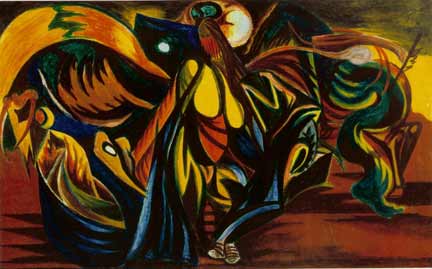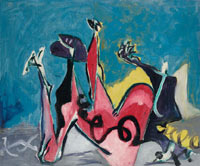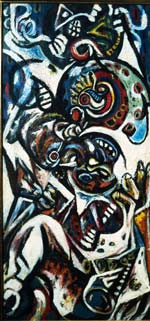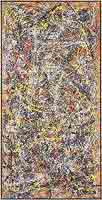Jackson Pollock and the Native American unconscious
by Judith Prescott
Article published on the 2008-10-24 Latest update 2008-10-24 13:34 TU
Jackson Pollock died in a car accident at the age of 44. Most talk of his art revolves around his famous action painting, or "drip technique". These are canvases on which the artist allowed paint to drip in an apparently abstract fashion. An exhibition in Paris takes a look at the influence of Native American culture on his work.
Culture: Pollock and shamanism exhibition
Until now, Pollock’s fascination with Amerindian art and rituals and their influence on his work has not been studied seriously. But this has changed with the exhibition "Pollock and Shamanism" at the Pinacothèque de Paris.
Art historian Stephen Polcari is the exhibition's curator. He says that Pollock, like the Surrealists, was known to be keenly interested in anything related to the unconscious. He believed the origins of art stemmed from the unconscious.
Polcari explains that during the 1930s and 1940s, the unconscious was considered a thinking process that involved a "primitive" reflex that could still be found in non-western peoples.
"Shamanism in American Indian culture is thought to be closer to the unconscious. It was a very big idea at the time", he says. "If you want to do the unconscious, you do primitive. And so Pollock did a lot of quote, unquote, 'primitive', using Shamanism to address the idea of the unconscious."
Alongside some 40 works by Pollock, which came from international museums and private collections, there are ritual and decorative objects from cultures of the Pacific Northwest and the Far North.
These include masks, a soul-catcher, a totem polem and an amulet and clearly show forms and images that Pollock used repeatedly in his own work.
Pollock was painting many of these canvases in period between the two World Wars. This was a time when the US was undergoing great change. Polcari says Shamanism for Pollock was a way of relating to, and understanding, those changes.
"I think he was interested in the idea of 'mass man', transforming man and finding the right personality for the new culture," he says. "America went from an 80 per cent rural country in 1880 to an 80 per cent urban country by 1930. And so there were a lot of questions about cultural identity and psychological identity. What is the proper role to have in this new world?"
Psychological theories, especially those of Carl Gustav Jung, were influential in this debate, Polcari says. "But there was a lot of discussion. Some was fearful. If you got the wrong combination it was marching and Nuremberg. There was a fear of mass culture."
The curator believes that even Pollock's famous drip technique can be reinterpreted in the light of his interest in Shamanism. He says people are fascinated by the drippings. Everybody looks at them and sees in them different things, but they don't look at them in the context of his early work.
"The first thing that has changed with the drippings is that we thought they were totally abstract", he says. " Now we see figures in them.
"We see he actually mixed in his earlier figures in his abstractions. You don't see them if you're not looking, but if you are attuned to it you see the figures. It's quite shocking, very shocking. For 50 years everyone thought, boom, boom, boom. Now we see that he's mixing this vitality with his previous shaministic figures."
The exhibition took two years to prepare and museum director Mark Restellini admits it was hard work. People are reluctant to lend the paintings because they are very fragile.
A few years ago a painting for an exhibition at Paris's Pompidou Centre was dropped and completely destroyed.
So make the best of this exhibition, says Restellini, because it could be the last time work by Pollock will be on display in the French capital.
Pollock and shamanism, Pinacothèque de Paris, 28 Place de la Madeleine, Paris, 15 October 2008 - 15 February 2009.
Culture
Cracking skulls!
2010-02-15 12:35 TU
France's gothic avant-garde
2010-02-13 15:16 TU
Winter sounds warm up French jazz fans
A tribute to trumpeter Don Cherry at a Free Jazz showcase festival outside of Paris.
2010-01-31 11:55 TU
Trance on a trapeze
2010-01-30 12:41 TU
Retro Mobile - classic car exhibition
260,500 euros for rusty old car found at bottom of lake
A rusty old Bugatti, which spent years at the bottom of a Swiss lake, sold for 260,500 euros at the Retro Mobile classic car exhibition on Saturday. Other more lovingly-restored pristine examples are exciting enthusiasts from across the world in a special anniversary event at Porte de Versailles in Paris.
2010-01-23 20:21 TU
France's changing face looks east
2010-01-22 16:17 TU
Putting art on film
2010-01-20 13:09 TU
What sex is a coffee bean, where does the aubergine come from?
2010-01-08 16:08 TU
Cocteau Twin flying solo
2010-01-06 16:43 TU
A taste of Nordic filmmaking in Paris
Ciné Nordica 2009 at Paris’s Panthéon cinema showcases filmmaking from Scandinavia. So what makes Nordic film different from the rest?
2009-12-22 17:15 TU


















